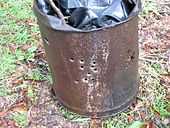Plinking
Plinking refers to informal target shooting done at nonstandard targets such as tin cans, glass bottles, and balloons filled with water.[1] The term is an onomatopoeia of the sound a bullet or other projectile makes when hitting a tin can, or other similar target, referring to the sharp, metallic sound, known as a "plink".
The most common calibre used for plinking is the .22 Long Rifle rimfire cartridge,[2] since these rounds are relatively inexpensive and have a low recoil, but airguns and airsoft guns are also used, often for cost or safety reasons or because they are subject to less stringent regulation.
Reasons for popularity
There are at least three major reasons for the popularity of plinking.
- Minimal costs and effort
Firstly, plinking has been popular because, in rural areas, one could start plinking with a minimum of preparation and expense. In hilly country with clay soil providing a safe backstop it is as simple as gathering up a few stray cans. In many rural areas, up until recent decades plinking was essentially the only way to regularly practice marksmanship. Certainly, a rural shooter might improvise a formalized paper target but even then, the rest of the shooting experience had the character of plinking.
- Shooting freedom

Secondly, plinking in general allows a shooter much freedom of choice in creating his or her shooting experience. In particular, the plinker is set at liberty from the very restrictive rules found at many gun ranges. Certainly, this freedom may be used to violate basic safety standards. However, other typical range rules which are not strictly matters of safety can also be ignored while plinking. Plinkers need not have fixed time periods of shooting before shooters have a chance to add, remove, check, or adjust their targets. In general, plinkers are free to shoot at their own pace.[2]
Many gun ranges also place restrictions on rate of fire, for instance mandating that shooters only fire one shot every three or five seconds. Thus, shooters equipped with a semi-automatic weapon, fully automatic weapon, or a revolver cannot get the full enjoyment out of shooting their firearm. This is typical of indoor ranges that require each shot to be carefully placed so as to limit the possibility of damage to the range equipment. While private indoor gun ranges sometimes allow rapid fire they can also have ammunition restrictions (frangible only, or lead only), charge more for shooting rifles than for shooting handguns, limit the caliber or bar some types of firearms outright while charging by the hour, creating a rushed session, contrasted with the relaxed nature and lack of time constraints one would get when plinking.
Another restriction is the use of firing lanes, where one may only shoot at targets that have been posted directly in front of the shooting area without the ability to pick different targets that are not directly perpendicular to the shooter. The informal nature of plinking means that some shooters will shoot at the same target or item (tin can, etc.) and make up games as they go. The lure of this is that there is still competition, without formal scoring or stringent firing rules and sequences.
- Best type of plinking range
The best places for plinking should be chosen by an experienced shooting instructor. Bullets can miss, ricochet, and fall from the sky with deadly force so he or she must consider these possibilities. The safest method for plinking is placing the target at the base of a large earthen mound relatively free of rocks (or other solid objects) in a rural area far away from people, livestock, cars, and houses. One should also consider the possibility of an inexperienced shooter and a stray bullet going over top the hill behind the intended target.
- Improvement of shooting skill
Plinking is also popular because it is very useful for improving shooting skills in a calm, relaxing, non-competitive environment. Plinking, unlike competitive shooting sports, provides immediate feedback on shooting skill. For example, if a shooter hits a can, there is immediate feedback of the can making a noise and moving. While if the shooter misses the target, a puff a dust in the dirt shows where the shooter actually did hit, allowing the shooters to immediately adjust sight picture, stance, method of gripping the firearm etc. It is not necessary when plinking to wait several minutes to walk down range, or to look through optical scopes to see holes in a distant target.
- Improvement of safety
Honing of actual shooting skills through plinking, away from a competitive and crowded environment, allows one to focus more clearly on gun safety than when one is actually participating in organized shooting events.
- Target choice

The third major reason for the popularity of plinking is that plinkers are able to choose their own targets. This reason is related to the first two. Many targets regularly used for plinking are cheaper to obtain and more commonly available than standard paper targets. Also, many of the targets can be reused multiple times, especially cans and other targets from durable material. Second, plinkers are able to use what are known as reactive targets (full water bottles or substances such as Tannerite which explode when struck with a rifle bullet) which, when hit, are more apt to display the full power of their weapons compared to paper targets hit with similar precision. Sometimes the intricacy of the target setup is more time consuming than the more typical method of target paper and frames.
See also
- Glossary of firearms terminology
- List of rifle cartridges
References
- ↑ "Plinking With Handguns". Retrieved 2007-09-24.
- ↑ 2.0 2.1 "The Zen of Plinking". Archived from the original on October 11, 2007. Retrieved 2007-09-24.
External links
- Power Plinker - Promoting the benefits of plinking.